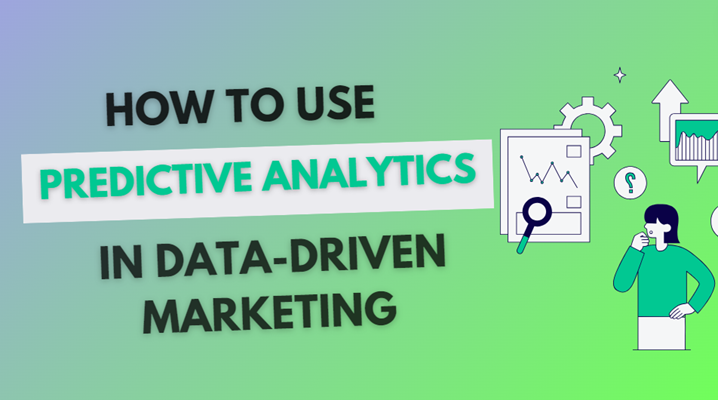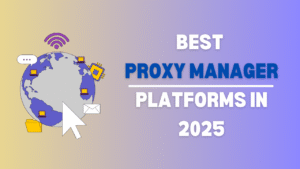In the present highly competitive digital world, making an educated guess is no longer sufficient to prosper in marketing. With each click, purchase, or interaction, customers leave traces of information behind that can inform businesses. So how do marketers then take the raw data and convert it into effective strategies that optimize returns, optimize customer experience, and put their campaigns into the future?
The answer is predictive analytics—a revolutionary approach that utilizes AI, machine learning, and statistical modeling to forecast trends, predict customer behavior, and optimize marketing with unmatched precision. From personalized recommendations that drive conversions to churn prediction models that avoid revenue loss, predictive analytics empowers marketers to shift from reactive to proactive decision-making.
Unlocking the Art of Predictive Analytics: Crafting Tomorrow’s Insights
Predictive analytics, in the simplest of terms, is an advanced process that employs historical information to discover patterns and trends that predict future events. This complex process involves the application of statistical algorithms and advanced machine learning processes, yielding valuable information about consumers’ preferences and tastes to marketers. The guidelines encompass the necessity of accurate data, selective model choice, and ongoing refinement.
Predictive analytics functions in a complex system that has core components such as data collection, preprocessing, and model development. Data collection is the merging of various forms of data, and preprocessing is ensuring the data is quality and reliable. Building predictive models employs a variety of approaches, ranging from classical statistics to contemporary machine learning methods. The broad scope enables marketers to be flexible with their approach and extract meaningful insights from the intricate data. Predictive analytics, in this evolving landscape, is not just a tool but a skill that creates insights for the future and enables intelligent decision-making.
Demystifying Data Analytics: Navigating Descriptive, Diagnostic, Predictive, and Prescriptive Insights
- The Analytics Spectrum:
In today’s new data analytics era, numerous possibilities are available, which enable the creation of insights and provide an integrated picture of business data. Exploration of the four fundamental types of data analytics—descriptive, diagnostic, predictive, and prescriptive—provides analysts with a map with which to manage the complexity of data-driven decisions with ease.
- Descriptive Analytics: Descriptive analytics is based on historical data to provide a clear picture of what occurred in the past. It provides simple answers to the ‘what’ questions—providing trend, pattern, and key performance indicators that enable one to comprehend how businesses have behaved in the past.
- Diagnostic Analytics: Beyond the ‘what,’ diagnosis analytics explores the ‘why.’ Through closer examination of past data, diagnosis analytics attempts to determine why specific results or occurrences have happened. It provides for deeper insight into the primary causes and elements underlying observed trends, permitting a more reflective analysis.
- Predictive Analytics: Predictive analytics aids decision-making through the use of statistical methods and machine learning. With the examination of past data, it predicts future trends and allows companies to foresee results and respond ahead of time. It is a strategic tool in being ahead of the changing business landscape.
- Prescriptive Analytics: At the top of analytics, prescriptive analytics is beyond simple outcome forecasting. It gives recommendations that can improve outcomes. By analyzing different possible scenarios and their possible effect, prescriptive analytics allows decision-makers to determine the best way of acting in a complicated business situation.
- Empowering Decision-Making: Having this analytics continuum at their disposal provides analysts and marketers with an entire toolset. This toolset allows them to seamlessly transition from deriving insight in historical data with descriptive analytics to making smart, data-based decisions for the future with prescriptive analytics. Along the way, each analytics type contributes to the development of a comprehensive understanding to facilitate strategic decision-making.
The Role of Data in Predictive Analytics:
- Data Collection Methods: Predictive analytics begins with sound data collection methods. These involve customer interactions gathered through multiple contact points, demographic data that provides insight into target markets, and information about online behaviors. A comprehensive dataset is crucial. The success of predictive analytics is based on the diversity and quality of data captured.
- Data Preprocessing and Quality: The phrase “garbage in, garbage out” illustrates the importance of data quality in predictive analytics. Cleaning, conversion, and normalization of data are all necessary preprocessing steps to achieve accuracy. Accurate predictions rely on meticulous data preparation free of errors and biases that can ruin the analysis.
- Structured vs. Unstructured Data: In predictive analytics, it is very crucial to understand the difference between structured and unstructured data. Structured data is presented in fixed forms like databases, while unstructured data is relatively more free-flowing and contains items like emails, social media updates, and multimedia. An effective predictive analytics approach appreciates both forms of data, learning from structured databases and coping with the complexities of unstructured data.
Building Predictive Models for Marketing:
- Types of Predictive Models: The essence of predictive analytics is the creation of models that take data and translate it into useful information. Marketers should be aware of various models in order to make the best out of their strategies. Linear regression models are simple to manage and interpret, decision trees provide a straightforward look into decision-making, and sophisticated machine learning algorithms delve into the intricacy of big data and deliver very high accuracy.
- Model Training and Validation: Building predictive models is not a one-off task; it is a task repeated and repeated. The task entails training models with past data so that they are able to detect patterns and associations. The real challenge comes when validating, and we test how accurate and consistent the models are. Ongoing improvement and modifications based on validation results mean that predictive models learn to keep pace with changing market dynamics.
- Applications in Marketing: Predictive models are used in a variety of roles in marketing. Predictive models aid in demand projections by forecasting what the customer will need in the future. Predictive models also help with price optimization, helping companies choose prices that consumers will expect. Lead scoring is another use, helping companies focus on potential customers most likely to purchase, maximizing sales efforts.
Predictive Analytics Models for Marketing
| Model Type | Best For | Data Required | Popular Tools |
| Linear Regression | Sales forecasting, Pricing strategies | Historical sales, Marketing spend | Excel, Python (Scikit-learn) |
| Decision Trees | Customer segmentation, Lead scoring | Demographics, Purchase history | IBM SPSS, RapidMiner |
| Random Forest | Churn prediction, Campaign optimization | Engagement metrics, Support tickets | SAS, KNIME |
| Neural Networks | Behavioral predictions, Image analysis | Clickstream data, Social media activity | TensorFlow, Google AutoML |
| Time Series Analysis | Demand forecasting, Inventory management | Seasonal sales data, Website traffic | Tableau, Prophet (Facebook) |
| Clustering (K-Means) | Audience segmentation, Market basket analysis | Transaction logs, Browsing behavior | R, Alteryx |
Predictive Analytics in Customer Segmentation:
- Segmentation Strategies: Knowledge of customer behavior is extremely important in the development of specific marketing strategies. Customer segmentation, using predictive analytics, is used to further such knowledge by dividing consumers into different types based on common traits. This can include age, behavior, and attitude, giving a holistic basis to specific marketing strategies.
- Enhancing Personalization: Implementing predictive analytics within customer segmentation further enhances personalization. Segments of customers sorted according to their own attributes allow marketers to plan content and offerings appropriate for every group’s desires. This niche approach not only increases customer happiness but also adds to the possibilities of conversion, making it straightforward to build strong relationships between companies and customers.
- Dynamic Customer Profiles: Dynamic Customer Profiles: Customers are not static; their preferences and behavior evolve over time. Predictive analytics refreshes customer profiles by using the latest data from continuous data analysis. This dynamism allows marketers to adapt to shifting consumer trends, adjusting their strategies in real time to remain active and relevant.
Personalized Marketing Campaigns:
- Tailoring Content and Offers: The age of mass marketing messages is gone, to be followed by personalized content and promotions. Predictive analytics enables marketers to personalize their messages in a way that each message resonates with the individual interests. From product recommendations to exclusive offers, personalization does not only demand attention but also establishes a bond between the customer and the brand.
- Behavioural Predictions: Anticipating and responding to customers’ behavior is the cornerstone of successful marketing. At the core of this lies predictive analytics with an analysis of past interactions and predicting future behavior patterns. This data allows marketers to respond in advance of customers’ needs, whether by communication, incentives or product positions that are personalized to them.
Churn Prediction and Retention Strategies:
- Identifying Churn Indicators: Customer retention in business is as vital as customer acquisition. Predictive analytics comes in handy here by spotting the early warning signals that they might be departing. Through analyzing past data and spotting trends regarding customers who stop engaging, companies can take an early step and prevent them from departing.
- Proactive Retention Strategies: Using churn prediction data, companies can act in order to maintain their customers. Targeted communications, discounts, and loyalty programs are some of the means through which predictive analytics assists companies in reaching potential churning customers, fostering loyalty, and preventing churn reasons.
- Measuring Retention Success: Measuring Retention Success: Effectiveness is gauged in terms of results, and the success of retention efforts is no different. Predictive analytics broadens its scope in gauging retention success by offering metrics and KPIs that reflect the effect of efforts undertaken. Ongoing monitoring and optimization based on these metrics render retention efforts agile and responsive to changing customer needs.
Optimizing Marketing ROI:
- Resource Allocation: Marketing budgets are finite, and maximizing return on investment (ROI) is always a challenge. Predictive analytics is like a good friend in this regard, assisting marketers in making the most of their resources. With the identification of the channels and campaigns that stand the highest possibility of success, companies can make the most of their marketing expenditure without exceeding budget constraints.
- Attribution Modelling: Attribution modeling provides us with insight into how well marketing channels are performing. Predictive analytics assists by dissecting the impact of each channel on the customer journey. Through first-touch, last-touch, or multi-touch attribution models, companies know how various points of contact influence consumer choice.
- Continuous Monitoring and Adjustment: Enhancing marketing ROI is a process that requires constant upkeep and adaptability. Predictive analytics achieves this by enabling ongoing monitoring of marketing activities. Through being cognizant of changes in the market and how consumers are acting, companies can make changes rapidly, so that their marketing is in sync with emerging trends and tendencies.
Choosing the Right Predictive Analytics Tool
In data marketing, choosing the optimal predictive analytics tool is an important choice for businesses. There are many options, and each has strengths and weaknesses. Ease of use, whether it will grow with the business, and how well it will integrate with current systems should be used to make this choice. A good choice is the Live Enterprise suite because it offers a complete solution that meets the main requirements for effective predictive analytics in marketing.
Key Challenges Associated with Predictive Analytics in Data-Driven Marketing
1. Data Quality:
Challenge:
- The accuracy and reliability of predictive analytics heavily depend on the quality of the data in use.
Impact:
- Poor-quality data can lead to inaccurate predictions and insights that might be flawed, undermining the effectiveness of predictive analytics.
2. Data Privacy Concerns:
Challenge:
- As predictive analytics relies heavily on vast amounts of data, businesses must navigate data privacy regulations and ensure compliance.
Impact:
- Mishandling of sensitive information can lead to legal consequences, damage reputation, and affect customer trust.
3. Model Complexity:
Challenge:
- Predictive analytics models can be complex, which makes them challenging to interpret, especially for non-technical users.
Impact:
- Lack of understanding might affect effective decision-making and limit the broader adoption of predictive analytics across the organization.
4. Bias in Predictive Models:
Challenge:
- Predictive models can, by mistake, include biases present in historical data, perpetuating existing disparities.
Impact:
- Biased predictions might lead to unfair or discriminatory outcomes. This will result in impacting various aspects of decision-making.
5. Data Integration Issues:
Challenge:
- Integrating diverse data sources and types can be a complex process that requires compatibility and flawless interoperability.
Impact:
- Incomplete or inaccurate integration can compromise the holistic view of data, decreasing the accuracy of predictions.
6. Resource Intensiveness:
Challenge:
- Developing and maintaining predictive analytics models usually requires substantial computational resources and skilled people.
Impact:
- Resource constraints might limit the scalability and accessibility of predictive analytics within an organization.
7 . Overfitting and Underfitting:
Challenge:
- Balancing the complexity of predictive models is very important to avoid overfitting (capturing noise) or underfitting (oversimplifying).
Impact:
- Overfitting might result in models performing well on training data but poorly on new data, while underfitting might lead to oversimplified, models that are less accurate.
8 . Changing Data Patterns:
Challenge:
- Predictive models assume that historical patterns will continue in the future, but real-world data patterns keep changing.
Impact:
- Unexpected shifts in data patterns can affect existing models less effectively, requiring constant monitoring and adaptation.
9. Interpretable Models:
Challenge:
- Some advanced predictive models, like neural networks, are often treated as “black boxes,” making interpretation challenging.
Impact:
- Lack of model interpretability can hinder stakeholders’ trust and acceptance of predictive analytics-driven insights.
10. Costs and Return on Investment (ROI):
Challenge:
- Implementing and maintaining predictive analytics systems can be resource-intensive, and organizations need to weigh costs against the expected benefits.
Impact:
- Inadequate consideration of costs and ROI may lead to inefficient resource allocation and suboptimal outcomes.
In conclusion, predictive analytics is a powerful tool in data-driven marketing. This guide has explained the basics of predictive analytics, including its main ideas and methods, as well as how it can be used for customer segmentation, personalized marketing campaigns, and strategies for predicting and keeping customers. As businesses work to improve their marketing returns, they also face challenges and ethical issues, making sure to use predictive analytics responsibly and clearly. Use predictive analytics to see a big change in your marketing strategies – where smart choices lead to focused, effective, and more successful campaigns.
Key Takeaways
- Unleash Predictive Power: Explore the game-changing impact of predictive analytics on marketing strategies.
- Data-Driven Mastery: Elevate your campaigns through strategic decision-making backed by data-driven insights.
- Decipher Customer Behaviour: Dive deep into customer behaviour analysis for more targeted and effective campaigns.
- Cutting-Edge Machine Learning: Stay ahead in marketing trends by embracing the latest in machine learning technologies.
- Optimize with Predictive Modeling: Maximize ROI by optimizing campaigns and personalizing strategies through predictive modeling.
Explore our other AI-focused blogs and uncover how AI is revolutionizing every aspect of marketing, from content creation to visual branding. Stay at the forefront of marketing innovation – check them out now!
- 20 Best AI Marketing Tools to Improve Marketing ROI“,
- Skills Needed for a Marketing Team to Effectively Leverage AI
FAQs
1. What’s the ROI of predictive marketing analytics?
- Businesses report:
- 20–30% higher conversion rates
- 15–25% lower customer acquisition costs
2. How does predictive analytics handle real-time data?
- APIs integrate live data (e.g., website clicks) into models for instant updates (e.g., adjusting ad bids).
3. Can small businesses use predictive analytics?
- Yes! Start with:
- Free tools: Google Analytics’ predictive metrics
- Low-cost: HubSpot’s predictive lead scoring
4. How long does it take to implement predictive analytics?
- Basic models: 2–4 weeks (e.g., churn prediction)
- Complex systems: 3–6 months (e.g., dynamic pricing engines)






